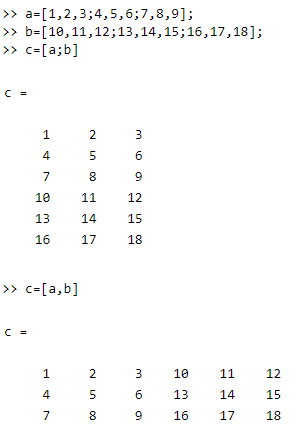An Interest In:
Web News this Week
- April 26, 2024
- April 25, 2024
- April 24, 2024
- April 23, 2024
- April 22, 2024
- April 21, 2024
- April 20, 2024
MATLAB MONDAYS- Crash Course part-4
Welcome all! This Monday let us learn all about matrices in MATLAB, and how to generate them
Making matrices in MATLAB
We will now learn how to create Matrices in MATLAB.
Similer to row vectors, the elements in a row are separated by a ',' and column by a ';'. First, type in the values for the first column separated by commas. When the row ends, type a semicolon and the proceed on to the next row. Repeat until done, and end with the square brackets.
Mismatch of elements in rows or columns generates this error-
Fusing two Matrices
In a similar way of making matrices, we can combine them together with this syntax
a=[ ]b=[ ]c=[a;b]This is vertical concatenation. The two matrices will be placed one on top of the other and joined together
For horizontal concatenation, use the syntax c=[a,b]
Note, For horizontal Concatenation, the number of rows for both matrices must be the same, and for vertical concatenation, the number of columns must be equal. If tis rule is violated, Concatenation error is generated.
Matrix generation functions
There are a few matrix generation functions in MATLAB like eye() this function generates an Identity matrix of the size we input.
example-
>> I=eye(10)I = 1 0 0 0 0 0 0 0 0 0 0 1 0 0 0 0 0 0 0 0 0 0 1 0 0 0 0 0 0 0 0 0 0 1 0 0 0 0 0 0 0 0 0 0 1 0 0 0 0 0 0 0 0 0 0 1 0 0 0 0 0 0 0 0 0 0 1 0 0 0 0 0 0 0 0 0 0 1 0 0 0 0 0 0 0 0 0 0 1 0 0 0 0 0 0 0 0 0 0 1The zeros() function creates a square martix of zeros
For rectangular matrices, two arguments can be used.
>> z=zeros(3)z = 0 0 0 0 0 0 0 0 0>> z=zeros(3,5)z = 0 0 0 0 0 0 0 0 0 0 0 0 0 0 0We can use the exact same syntax for the ones function and the rand function.
>> x=rand(5,6)x = 0.8147 0.0975 0.1576 0.1419 0.6557 0.7577 0.9058 0.2785 0.9706 0.4218 0.0357 0.7431 0.1270 0.5469 0.9572 0.9157 0.8491 0.3922 0.9134 0.9575 0.4854 0.7922 0.9340 0.6555 0.6324 0.9649 0.8003 0.9595 0.6787 0.1712>> x=ones(5,6)x = 1 1 1 1 1 1 1 1 1 1 1 1 1 1 1 1 1 1 1 1 1 1 1 1 1 1 1 1 1 1Similarly there is the diag function for a diagonal matrix
>> x=diag(1:7)x = 1 0 0 0 0 0 0 0 2 0 0 0 0 0 0 0 3 0 0 0 0 0 0 0 4 0 0 0 0 0 0 0 5 0 0 0 0 0 0 0 6 0 0 0 0 0 0 0 7That's all for today. For any suggestions or doubts, please comment below (they do motivate me a lot...) Follow me for updates...
Also, you can gmail me for any suggestion or help
Bye for now
Happy to help always.....
Meet you all soon
Original Link: https://dev.to/aatmaj/matlab-mondays-crash-course-part-4-2c43
Dev To
 An online community for sharing and discovering great ideas, having debates, and making friends
An online community for sharing and discovering great ideas, having debates, and making friendsMore About this Source Visit Dev To





